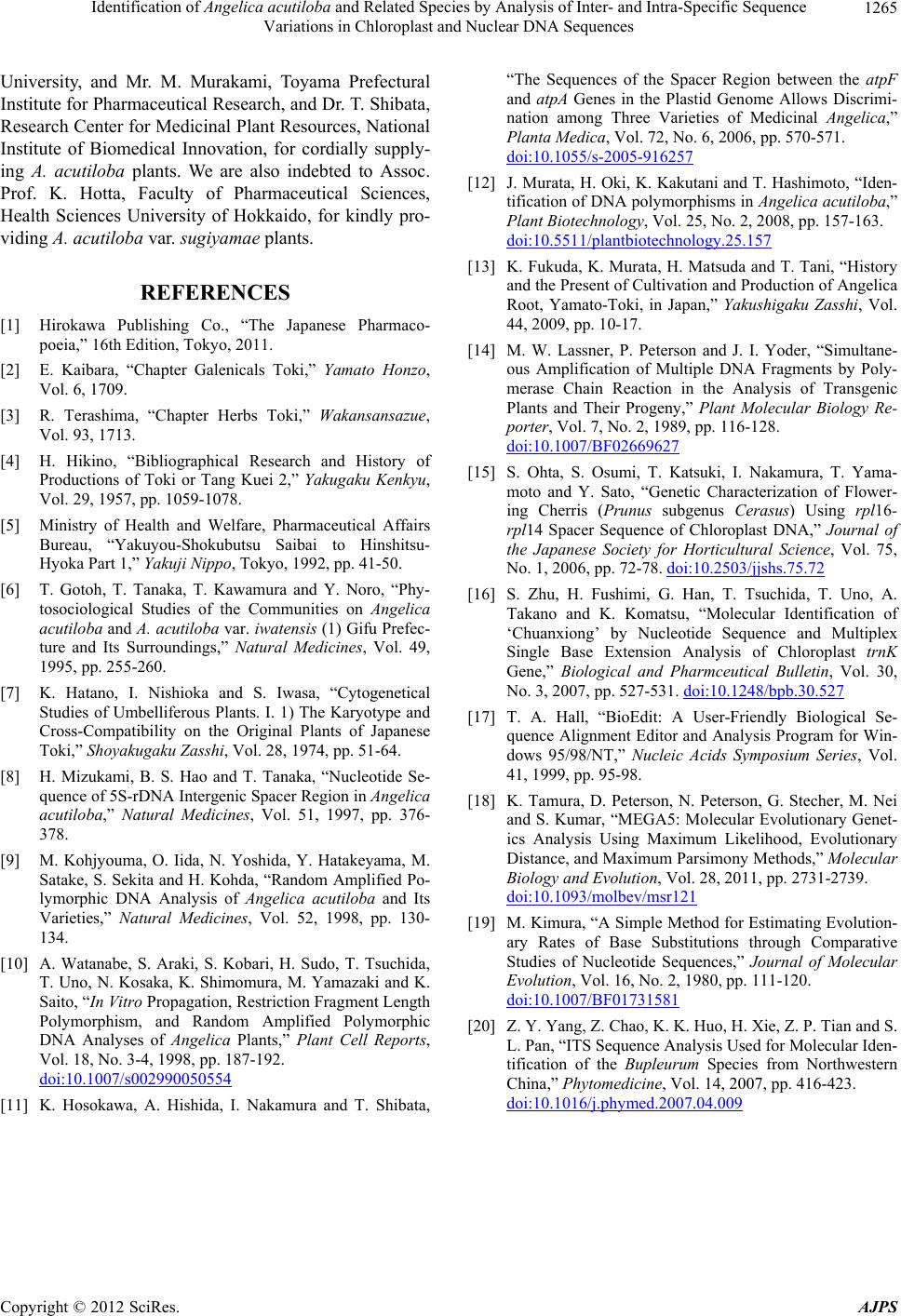
Identification of Angelica acutiloba and Related Species by Analysis of Inter- and Intra-Specific Sequence
Variations in Chloroplast and Nuclear DNA Sequences 1265
University, and Mr. M. Murakami, Toyama Prefectural
Institute for Pharmaceutical Research, and Dr. T. Shibata,
Research Center for Medicinal Plant Resources, National
Institute of Biomedical Innovation, for cordially supply-
ing A. acutiloba plants. We are also indebted to Assoc.
Prof. K. Hotta, Faculty of Pharmaceutical Sciences,
Health Sciences University of Hokkaido, for kindly pro-
viding A. acutiloba var. sugiyamae plants.
REFERENCES
[1] Hirokawa Publishing Co., “The Japanese Pharmaco-
poeia,” 16th Edition, Tokyo, 2011.
[2] E. Kaibara, “Chapter Galenicals Toki,” Yamato Honzo,
Vol. 6, 1709.
[3] R. Terashima, “Chapter Herbs Toki,” Wakansansazue,
Vol. 93, 1713.
[4] H. Hikino, “Bibliographical Research and History of
Productions of Toki or Tang Kuei 2,” Yakugaku Kenkyu,
Vol. 29, 1957, pp. 1059-1078.
[5] Ministry of Health and Welfare, Pharmaceutical Affairs
Bureau, “Yakuyou-Shokubutsu Saibai to Hinshitsu-
Hyoka Part 1,” Yakuji Nippo, Tokyo, 1992, pp. 41-50.
[6] T. Gotoh, T. Tanaka, T. Kawamura and Y. Noro, “Phy-
tosociological Studies of the Communities on Angelica
acutiloba and A. acutiloba var. iwatensis (1) Gifu Prefec-
ture and Its Surroundings,” Natural Medicines, Vol. 49,
1995, pp. 255-260.
[7] K. Hatano, I. Nishioka and S. Iwasa, “Cytogenetical
Studies of Umbelliferous Plants. I. 1) The Karyotype and
Cross-Compatibility on the Original Plants of Japanese
Toki,” Shoyakugaku Zasshi, Vol. 28, 1974, pp. 51-64.
[8] H. Mizukami, B. S. Hao and T. Tanaka, “Nucleotide Se-
quence of 5S-rDNA Intergenic Spacer Region in Angelica
acutiloba,” Natural Medicines, Vol. 51, 1997, pp. 376-
378.
[9] M. Kohjyouma, O. Iida, N. Yoshida, Y. Hatakeyama, M.
Satake, S. Sekita and H. Kohda, “Random Amplified Po-
lymorphic DNA Analysis of Angelica acutiloba and Its
Varieties,” Natural Medicines, Vol. 52, 1998, pp. 130-
134.
[10] A. Watanabe, S. Araki, S. Kobari, H. Sudo, T. Tsuchida,
T. Uno, N. Kosaka, K. Shimomura, M. Yamazaki and K.
Saito, “In Vitro Propagation, Restriction Fragment Length
Polymorphism, and Random Amplified Polymorphic
DNA Analyses of Angelica Plants,” Plant Cell Reports,
Vol. 18, No. 3-4, 1998, pp. 187-192.
doi:10.1007/s002990050554
[11] K. Hosokawa, A. Hishida, I. Nakamura and T. Shibata,
“The Sequences of the Spacer Region between the atpF
and atpA Genes in the Plastid Genome Allows Discrimi-
nation among Three Varieties of Medicinal Angelica,”
Planta Medica, Vol. 72, No. 6, 2006, pp. 570-571.
doi:10.1055/s-2005-916257
[12] J. Murata, H. Oki, K. Kakutani and T. Hashimoto, “Iden-
tification of DNA polymorphisms in Angelica acutiloba,”
Plant Biotechnology, Vol. 25, No. 2, 2008, pp. 157-163.
doi:10.5511/plantbiotechnology.25.157
[13] K. Fukuda, K. Murata, H. Matsuda and T. Tani, “History
and the Present of Cultivation and Production of Angelica
Root, Yamato-Toki, in Japan,” Yakushigaku Zasshi, Vol.
44, 2009, pp. 10-17.
[14] M. W. Lassner, P. Peterson and J. I. Yoder, “Simultane-
ous Amplification of Multiple DNA Fragments by Poly-
merase Chain Reaction in the Analysis of Transgenic
Plants and Their Progeny,” Plant Molecular Biology Re-
porter, Vol. 7, No. 2, 1989, pp. 116-128.
doi:10.1007/BF02669627
[15] S. Ohta, S. Osumi, T. Katsuki, I. Nakamura, T. Yama-
moto and Y. Sato, “Genetic Characterization of Flower-
ing Cherris (Prunus subgenus Cerasus) Using rpl16-
rpl14 Spacer Sequence of Chloroplast DNA,” Journal of
the Japanese Society for Horticultural Science, Vol. 75,
No. 1, 2006, pp. 72-78. doi:10.2503/jjshs.75.72
[16] S. Zhu, H. Fushimi, G. Han, T. Tsuchida, T. Uno, A.
Takano and K. Komatsu, “Molecular Identification of
‘Chuanxiong’ by Nucleotide Sequence and Multiplex
Single Base Extension Analysis of Chloroplast trnK
Gene,” Biological and Pharmceutical Bulletin, Vol. 30,
No. 3, 2007, pp. 527-531. doi:10.1248/bpb.30.527
[17] T. A. Hall, “BioEdit: A User-Friendly Biological Se-
quence Alignment Editor and Analysis Program for Win-
dows 95/98/NT,” Nucleic Acids Symposium Series, Vol.
41, 1999, pp. 95-98.
[18] K. Tamura, D. Peterson, N. Peterson, G. Stecher, M. Nei
and S. Kumar, “MEGA5: Molecular Evolutionary Genet-
ics Analysis Using Maximum Likelihood, Evolutionary
Distance, and Maximum Parsimony Methods,” Molecular
Biology and Evolution, Vol. 28, 2011, pp. 2731-2739.
doi:10.1093/molbev/msr121
[19] M. Kimura, “A Simple Method for Estimating Evolution-
ary Rates of Base Substitutions through Comparative
Studies of Nucleotide Sequences,” Journal of Molecular
Evolution, Vol. 16, No. 2, 1980, pp. 111-120.
doi:10.1007/BF01731581
[20] Z. Y. Yang, Z. Chao, K. K. Huo, H. Xie, Z. P. Tian and S.
L. Pan, “ITS Sequence Analysis Used for Molecular Iden-
tification of the Bupleurum Species from Northwestern
China,” Phytomedicine, Vol. 14, 2007, pp. 416-423.
doi:10.1016/j.phymed.2007.04.009
Copyright © 2012 SciRes. AJPS